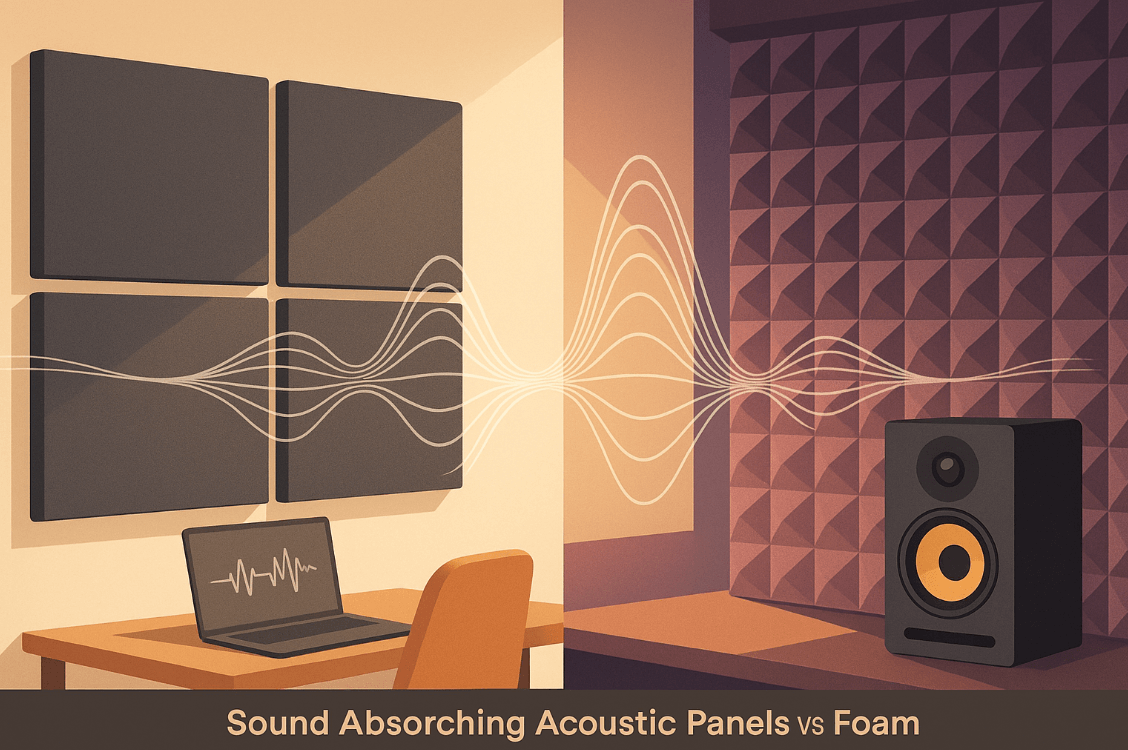Sound Absorbing Acoustic Panels vs Foam: Which Is Better?
Traffic rumbling outside, HVAC fans whirring overhead, students shuffling papers — unwanted noise chips away at focus and comfort. Sound absorbing acoustic panels tame those reflections by turning kinetic sound energy into a trace of heat inside their fibrous cores. When placed correctly, they cut reverberation time (RT60) dramatically: in one eighth-grade classroom I treated last February, RT60 fell from 1.1 s to 0.48 s, and the teacher reported a 20 % drop in “please-be-quiet” reminders in the first week.

How Sound Absorption Works
Porosity & Cell Structure
Panels made from dense polyester felt, rigid fiberglass, or mineral wool trap sound in micro-channels. Viscous losses in those pores convert the wave to heat; the thicker (and heavier-per-unit-volume) the blanket, the lower the frequencies it can tame. Laboratory tests following ISO 354 / ASTM C423-22 routinely show NRC values above 0.90 for 50 mm PET boards at 60 kg m⁻³ density.
NRC & STC Ratings Demystified
-
NRC (Noise Reduction Coefficient) — average absorption (0 = mirror, 1 = black-hole). Think of it like sunscreen SPF for your ears.
-
STC (Sound Transmission Class) — how well a wall/ceiling system blocks sound between rooms.
Rule of thumb: use NRC≥0.75 for open offices and NRC≥0.90 for recording spaces.
Sound Absorbing Acoustic Panels vs Foam: Head-to-Head Comparison
Material Composition & Construction
| Attribute | Fabric-Wrapped Panels | Polyurethane Foam |
|---|---|---|
| Core | Fiberglass / PET felt (25-100 mm) | Open-cell PU (25-50 mm) |
| NRC @ 50 mm | 0.90 | 0.55 |
| Fire rating | ASTM E84 Class A | Varies; many Class B / C |
| Lifespan | 10-15 yrs fabric-replaceable | 3-5 yrs (UV yellowing) |
“Rigid core panels keep absorption flat to 250 Hz, while foam tails off below 500 Hz,” notes Dr. Jorge Silva, author of Practical Room Acoustics.
Application Case Studies & Real-World Results
Home Studio Upgrade
Twelve 600 × 1200 mm panels behind mix points cut 8 dB from first-reflection peaks, eliminating the need for surgical EQ.
Classroom Retrofit (First-Person Experience)
In a 70 m³ science room, I calculated the target RT60 with Sabine’s formula T60 = 0.161 · V / A. Adding 18 PET felt baffles (total absorption area ≈ 46 m²) halved reverberation, raised speech transmission index (STI) from 0.55 to 0.71, and students at the back row scored 11 % higher in an identical comprehension quiz the next day.
Open-Plan Office Case Study
A logistics firm mounted 40 mm PET clouds and desk dividers; reverberation shrank from 1.2 s to 0.55 s, and post-survey acoustics satisfaction jumped 31 %.
Cost, Durability & Maintenance Factors
Up-Front Pricing & Bulk Discounts
-
PET felt: $6–$9 / ft² retail, 15–25 % off in pallet lots.
-
Fabric-wrapped fiberglass: $8–$12 / ft²; factory-direct rates drop near $7 for 500 ft²+. Market analysts expect sustained demand, with global acoustic-panel revenue growing from USD 13.1 bn (2024) to 24.2 bn (2034) at 7.2 % CAGR.
Lifespan, Cleaning & Warranty
UV-stable fabrics and hard-edge frames last 10–15 years indoors; most suppliers (including Wellco) back them with a 5-year no-sag warranty. Vacuum quarterly and spot-clean with mild detergent to extend service life.
Installation & Safety Considerations
DIY vs Professional Mounting
Lightweight panels (< 2 kg) hang easily on Z-clips or adhesive strips; heavier clouds need threaded anchors into joists. For sprinkler-dense ceilings, engage a certified installer to maintain clearance codes.
Fire & Indoor-Air Certifications
Look for ASTM E84 Class A and OEKO-TEX® / GREENGUARD Gold credentials. Wellco’s PET line ships with Intertek report #IG-AP-3421-25 and downloadable certificate link WW-AP-UL2025-22 for compliance files.
Sourcing & Customization Options
Factory-Direct Benefits with Wellco Wholesale
ISO 9001-certified Wellco Wholesale offers trade bundles of sound absorbing acoustic panels (and your farm-to-hotel supply staples). Advantages:
-
Custom sizes & edge profiles down to ±1 mm.
-
50+ fabric colours or printable graphics for branding.
-
Freight-optimised cartons that trim shipping costs ≈ 12 %.
Single-room starter kits ship next-day from three U.S. depots, so individual DIYers aren’t left out.
Conclusion
Whether you’re mastering a record, calming a classroom, or boosting productivity in an open office, choosing high-density cores, verified fire ratings, and thoughtful placement pays dividends in clarity and comfort. Calculate your RT60, pick NRC-rated panels, and let Wellco Wholesale deliver factory-direct value. Request your free swatch kit and acoustic consult today.
Frequently Asked Questions
Q1: How many panels do I need for a 20 m² home studio?
Start with coverage ≈ 20 % of wall area (about eight 600 × 1200 mm panels) and measure RT60 again for fine-tuning.
Q2: Can I paint fabric-wrapped panels?
Light fabric paint is fine, but heavy latex can clog pores and lower NRC. Opt for custom-coloured fabrics instead.
Q3: Are PET felt panels eco-friendly?
Yes. Many are 60–80 % post-consumer PET and are recyclable at the end of life.
Q4: What is the typical lead time for custom sizes?
Factory-direct orders through Wellco ship in 10–14 days, including colour matching and edge finishing.
Q5: Do panels off-gas VOCs?
Panels carrying GREENGUARD Gold certification emit < 0.5 mg/m³ formaldehyde equivalents, well below classroom IAQ guidelines.

